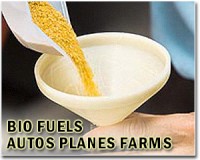 |
West Lafayette IN (SPX) Jan 28, 2010 Researchers from Purdue University and Cummins Inc. have developed an advanced "closed-loop control" approach for preventing diesel engines from emitting greater amounts of smog-causing nitrogen oxides when running on biodiesel fuels. Operating truck engines on a blend of biodiesel and ordinary diesel fuel dramatically reduces the emission of particulate matter, or soot. However, the most modern and efficient diesel engines burning biodiesel emit up to 40 percent more nitrogen oxides at some operating conditions, and fuel economy declines by as much as 20 percent. Unlike conventional diesel, biodiesel contains oxygen, and the researchers have shown that this presence of oxygen is responsible for the majority of the higher emission of nitrogen oxides, said Gregory Shaver, an assistant professor of mechanical engineering. Another key factor is a recent innovation called exhaust gas recirculation, which reroutes exhaust back into the engine cylinders to reduce emissions. The researchers found that nitrogen oxide emissions rise by a higher percentage in engines equipped with this exhaust-recirculation technology compared with older engines that do not. However, the newer engines still emit less nitrogen oxides than the older engines. The research addresses the need to reduce nitrogen oxide emissions and fuel consumption. Researchers at Purdue's Ray W. Herrick Laboratories used a Cummins 6.7-liter, six-cylinder diesel engine, a popular power plant found in Dodge Ram pickup trucks. "We were able to improve the fuel economy with a biodiesel blend while reducing nitrogen oxides to where they were with conventional diesel," Shaver said. "At the same time, we were able to maintain the customary biodiesel reductions in particulate matter emissions compared to ordinary diesel fuel while not increasing noise emissions." Fuel economy still is problematic, however, because biodiesel has 10 percent to 12 percent lower "energy density," or the amount of energy liberated during combustion, compared to regular diesel fuel, he said. "This means you get lower mileage for biodiesel compared to ordinary diesel fuel," Shaver said. "We improved the combustion efficiency and were able to get better mileage than before, but still not as good as conventional diesel fuel." Findings are detailed in a research paper that has been posted online and that will appear in an upcoming issue of the American Chemical Society journal Energy and Fuels. Researchers from Purdue and Cummins also authored a related paper regarding soy biodiesel blends that appeared online in October in the same journal. The researchers developed a physics-based, closed-loop control technique - which means the system uses advanced models to self-adjust engine settings based on feedback from sensors. Software algorithms use data from the sensors to determine the fuel blend being combusted. If the fuel is changed, the system identifies the new fuel and makes critical adjustments to fuel-injection timing, the air-to-fuel ratio and how much exhaust is rerouted into the cylinders. "You need to be able to estimate what the blend ratio is so you know what's going on in the engine," Shaver said. "Is it 20 percent biodiesel fuel mixed with 80 percent regular fuel? Then we can do something to reduce the nitrogen oxides to levels consistent with a conventional fuel that didn't have oxygen in it." Most late-model cars and trucks already are equipped with both oxygen sensors in their exhaust systems and sophisticated electronic control modules, making the technique applicable for both current and future vehicles, Shaver said. "It just adds another wrinkle or two of extra intelligence to an engine's electronic control module," Shaver said. The researchers extensively tested and simulated four blend ratios of biodiesel, focusing on soy-based fuel, which is the most commonly used biodiesel in the United States. The approach also could be used for other types of fuels and engines, including advanced lean-burn gasoline engines running on ethanol-gasoline blends. The paper was written by graduate student Michael Bounce; doctoral students David Snyder, Gayatri Adi and Carrie Hall; undergraduate students Jeremy Koehler and Bernabe Davila; Cummins engineers Shankar Kumar, Phanindra Garimella and Donald Stanton; and Shaver. Purdue has filed one full patent and one provisional patent related to the technique. The engine-control framework is ready for commercial use, and the researchers are working with engineers at Cummins Inc., Shaver said. The Purdue team also is studying how the techniques might be extended to electricity power generation and other alternative fuels.
Share This Article With Planet Earth
Related Links Purdue University Bio Fuel Technology and Application News
 Gene-altered bugs make biodiesel
Gene-altered bugs make biodieselParis (AFP) Jan 27, 2010 Gene scientists have coaxed bacteria into eating agricultural waste and secreting diesel, offering a potentially cheaper, greener energy source than present-day biofuels, a study released Wednesday said. Soaring demand for the current mainstay source for biodiesels - corn, sugar and other starchy crops - has caused the prices of some staple foods to soar as farmland is turned over to fuel ... read more |
|
| The content herein, unless otherwise known to be public domain, are Copyright 1995-2009 - SpaceDaily. AFP and UPI Wire Stories are copyright Agence France-Presse and United Press International. ESA Portal Reports are copyright European Space Agency. All NASA sourced material is public domain. Additional copyrights may apply in whole or part to other bona fide parties. Advertising does not imply endorsement,agreement or approval of any opinions, statements or information provided by SpaceDaily on any Web page published or hosted by SpaceDaily. Privacy Statement |